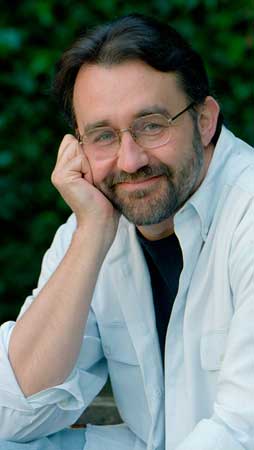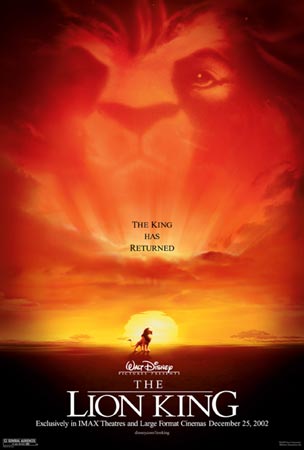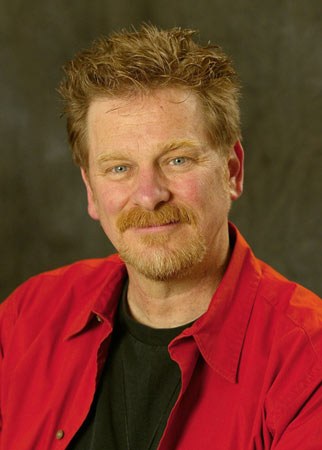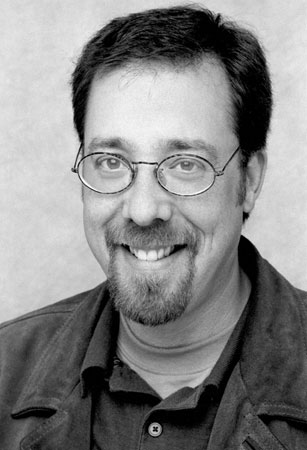The Lion King: The IMAX Experience.
|
Read more
at in70mm.com The 70mm Newsletter |
| Written by: William Kallay | December 2002 |
 "The
Lion King" producer, Mr. Don Hahn. © Disney Enterprises, Inc. "The
Lion King" producer, Mr. Don Hahn. © Disney Enterprises, Inc.If there was ever a king of the movie jungle, Disney's "The Lion King" is the one that roars well into the 21st Century. When it premiered in the summer of 1994, "The Lion King" set records at the box office and captivated audiences with its dynamic story, characters, stunning animation and songs that became Disney classics. Not only was the film a success at the movies, but also a multi-million-copy seller on videocassette. Later, it was transformed into a hit Broadway show. It seems that audiences can't get enough of the lion. So much so, that Disney has recently revived the film for IMAX and Large Format cinemas for the Christmas season. Producer Don Hahn, currently working on a film version of the Disney Theme Park attraction, "The Haunted Mansion" (tentatively due in 2003), spoke about his career and The IMAX version of the Disney classic. Kallay- When did you get your start at Disney? Hahn- I got my start 25 years ago as a P.A., a production assistant, as an artist, and eventually became really seduced by the process of making animated films. I loved working with people and the process of pulling these complex movies together with artists and musicians. That's how I got into it. I started producing on "Who Framed Roger Rabbit" (1988), "Beauty and the Beast" (1991) and "The Lion King", among many others. Kallay- On "Who Framed Roger Rabbit", did you produce the animated segments on that film? Hahn- I was the Associate Producer. I produced all of the animated segments on "Who Framed Roger Rabbit". That was my first baptism into producing. After that, I started producing "Beauty and the Beast" and after that, I started producing a movie called "King of the Jungle", which was to become "The Lion King". It was a little nature movie. "Bambi In Africa" is what we used to jokingly call it. There were days early on when we had trouble getting people to work on it, because they thought, "This is kind of like a dusty, National Geographic documentary and it didn't seem that exciting. And of course, it had a really happy ending. The movie ended up not only becoming a successful movie, but kind of a phenomenon and went onto the stage and now IMAX. It permeates our culture. (Laughter) Kallay- Why was it decided to go with an IMAX version of "The Lion King"? Hahn- We wanted to re-release the movie because by this time, there was a whole new generation of kids who haven't really seen it, particularly on the big screen. There's just a visceral response to movies when you see them projected on a really big screen. Since "The Lion King" was digitally archived, it was really a digital movie when we made it. We were able to take out the old data from each shot in the movie, and there's probably 1500 shots in the movie, and blow it up to the resolution for IMAX. What you have is a really pristine, clear, digitally enlarged image up on the IMAX screen. Along with that, we had the opportunity to do a big sound mix that makes the audience feel like they're in the middle of the movie. That's why we did it. Kallay- What do you expect audiences to experience from this larger version of the film? Hahn- Well, you feel like you're inside the movie. You feel like you're not watching it once removed, but the film actually fills your field of vision. And because of that, I think it's incredibly involving emotionally. You're able to feel like you're there in the midst of these characters fighting out their problems and victories. You know there's nothing as great as home theater. But there's nothing like the social aspect of going to the movies and seeing a movie with a group of people, and together, laughing and hopefully crying if we did our job right. That kind of social theatergoing is obviously centuries and centuries old, and I think it's really important for us communally to go to the theater, because those are our hopes for the audience to go see "The Lion King" in that manner. |
Further
in 70mm reading: Treasures On The Really Big Screen in70mm.com's IMAX Page An Interview With Jim Ward, V.P. of Marketing, Lucasfilm, Ltd. |
 "The
Lion King" 1-sheet IMAX release poster. © Disney Enterprises,
Inc. "The
Lion King" 1-sheet IMAX release poster. © Disney Enterprises,
Inc.Kallay- Is it a part of your job, as a producer, to instill in the animators and directors, that they're making a film for a big audience? Hahn- Yes, we are there to make a movie for ourselves, yes, but definitely the end is that we have to focus making a movie for the audience. When we were making "The Lion King" eight years ago, we test screened it about 11 times for that very reason; to go into a cinema and see the audience's reaction. Were there places where the kids got restless? Were there places where grownups walked out to take a bathroom break? It doesn't qualify as market research for us. It qualifies as a chance for us to be part of the audience, and along with our fellow audience members, react with them and remember what it's like to be an audience member. Because when you make these movies, you're so close to it, you don't get the chance to really look it dispassionately as an audience member, because you're in the midst of it. And this way, it allows you to put yourself in the shoes of the audience, and sit down in the middle of theater and hear people around you reacting, for better or for worse. Kallay- Do you like test screenings? Hahn- Well, I don't know if I like them, but they're a necessity. They're painful sometimes. You are terrified, because you've worked on a movie for often several years and you don't know what the audience reaction is going to be. The first "Who Framed Roger Rabbit" screening was a disaster. People walked out. They recruited an audience of a date-night crowd. The audience wasn't sure what the movie was, because it was unfinished. And that was in stark contrast some previews we had on "The Lion King", where you'd come out and the audience was buzzing about it and feels like they had seen something special and were really involved in the characters. You always learn a lot from these things. Kallay- Are there any new scenes that have been added to "The Lion King" like there was in "Beauty and the Beast"? Hahn- No, not really. We went back into maybe 80, or a 100 scenes, and enhanced them. For example, if you blew up a scene where there were a lot of characters in the distance around a water hole. For a regular multiplex, that would be just a held drawing, or a crudely done drawing, in cases if we were rushing. So we went through and really scrutinized the movie and found a couple places like where we had to go back in re-draw characters or re-clean up characters. The most notable of which was probably the "Weema Wep" scene when Pumbaa and Timon are coming towards us singing "The Lion Sleeps Tonight." And when we looked at that on a big screen for the first time, it was really rough. We never noticed on a small screen, so we actually went back in and Ron Husband, one of our animators on the original movie, went back and cleaned it up. We did the same to a lot of backgrounds, covered a lot of brush marks and things that showed up as you blow it up to this large format. Kallay- Do you think those brush marks are noticeable to an audience on an IMAX screen to where it's distracting, or do you think that the hand drawn elements show the "human" aspect of the animation? Hahn- It's always a debate. We didn't sanitize it. We had to draw a line and say, "How far do you go to remove the hand of the artist to take out what might appear to be a mistake or distraction?" You had to leave enough of the hand of the artist so you appreciate the artistry that's up there. That was a constant debate. And in the end, we did a little bit of both, but we tried not to sanitize the movie, or sterilize it so that it was technically pristine. What people love about an animated movie, particularly the hand-done animated movies, is they are like a handwritten letter. They're beautiful in their humanity. That's the only way I can describe it. I think the audience appreciates that. |
|
 "The
Lion King" co-director, Mr. Roger Allers. © Disney Enterprises, Inc. "The
Lion King" co-director, Mr. Roger Allers. © Disney Enterprises, Inc.Kallay- Was the animation for this film drawn on traditional cels, then scanned into the computer? Hahn- It was about the third movie in a string of movies that was produced digitally with hand drawn drawings, then the drawings were scanned into a scanner, a big massive, expensive scanner (laughter). The backgrounds, the same way, they're painted by hand with a paintbrush, scanned in and then they're composited with the characters and other levels of clouds, effects and details. Kallay- In a sense, it's almost like a digital version of the Multiplane Camera. Hahn- Very much so. And with the Multiplane Camera, there was always the limitation of doing maybe four levels, because it was composed of cels, glass and paint. When you've got more levels, you started picking up dirt and other artifacts. In a digital environment, the number of levels you can have, in a way, is an endless. Effectively, it's a Multiplane Camera with hundreds of levels. In "The Lion King", the only area of the movie that was digitally animated was, of course, the wildebeest stampede. Kallay- How do you feel that sequence holds up today with all of the new updates in computerized animation and GGI technology? Hahn- Great! It holds up really well. It makes me very proud of the people that did it, because it is, even to the discriminating viewer, a very, very satisfying piece of cinema. Kallay- Are there any scenes in the new version of "The Lion King" that you felt played better in IMAX, as opposed to the original release? Hahn- Yes. The wildebeest stampede would be one of them. There are moments elsewhere that play better when you open up the camera and you have, for example, Mufasa and Simba sitting on top of Pride Rock looking at the sunrise. Or at the end of the movie when the sun comes up on a bright new day and the clouds part, it's terrific. And then of course my favorite sequence in IMAX is when Mufasa's ghost shows up, Simba goes to the reflecting pool, sees his reflection, and then all of the sudden, the clouds form and Mufasa shows up. That's a stunning scene in IMAX. It came out pretty cool in the regular cinema, but to see a six-story tall apparition coming at you is very moving. Kallay- Did you feel that by going to IMAX, it puts an already epic movie into a different level, so to speak? Hahn- Well, it's a different way to appreciate it. If you hadn't seen it before, it's a different way to appreciate it again socially with other audience members, or with family, in a way that you can't really appreciate it at home. And I feel like that's the strength. The IMAX venues are terrific for education, too. I think a lot of what we're doing to support the movie is have educational materials. It's a window into a lot of topics for kids to go to an IMAX venue, a lot of which are associated with science centers. They will able to start discussing topics, like African music, or animated film, or computer graphics or African culture. And that's something that's important to us as a company. As filmmakers, we never thought of that. We're just trying to figure out how to make a movie! But now in retrospect, to be able to offer the movie and have those kind of opportunities is great, too. |
|
 "The
Lion King" co-director, Mr. Rob Minkoff. © Disney Enterprises, Inc. "The
Lion King" co-director, Mr. Rob Minkoff. © Disney Enterprises, Inc.Kallay- In regard to the original aspect ratio, did the conversion into the large format pose any re-framing problems for the animators? Hahn- No, not really. We had done it successfully on "Beauty and the Beast" the year before, so we had a process that worked really well. When we made the original movie, it was made for a 1.85:1 projection. But we also protect it, or animate it, with additional material on top and bottom. Ten years ago, we did that for video. We thought when it goes to the video screen, instead of cutting off the east and west of the picture, let's just add a little extra when it goes to video the audience will see a little extra. That's what really saved us when we go to IMAX format. As you know, the format is a little more square. And so it doesn't really pose any problems, if any anything, it gives people extra security. Kallay- I've heard a rumor that most Disney films, I would say in the past decade, are shot in Super 1.85. Is that true, or are they actually shot in 1.66 ratio? Hahn- It's a mix of both. If you held up our negative and looked at it, it would be 1.66:1, so it's not hard-matted to 1.85:1. It's 1.66:1. Where the "super" comes is that the negative is also Super 35, which means it goes out to the entire image area that takes up normally the soundtrack. The image goes from perforation-to-perforation on the film. So that's on the negative that gives us a little extra area. Now that didn't have anything to do with the IMAX version, because for IMAX, we pulled each scene off the shelf, and each scene is basically held a CD with data on it. The data went into a film printer. The film printer printed a new 15-perforation, 70mm IMAX frame. The disc was not reprinted from film elements, it was reprinted from digital elements. Kallay- Did the film require any restoration? Hahn- Well no, not really. Because again, we didn't start with film, we started with digital elements, so there was no having to deal with color or with scratches or anything, because it's digital material. Though occasionally, a file was corrupted or something wouldn't load up properly, so we had to debug it. That's the equivalent, I suppose, of the negative. But this wasn't just an enlargement from a piece of film. |
|
 The
star of "The Lion King", Mr. Simba. © Disney Enterprises,
Inc. The
star of "The Lion King", Mr. Simba. © Disney Enterprises,
Inc.Kallay- Was the soundtrack re-mastered for the large format environment? Hahn- It was. We went with Terry Porter, the original mixer and reformatted the mixing stage. IMAX has an extra speaker above the screen and we listened to it in that environment. We wanted to take full advantage of the IMAX sound system, which is spectacular, adding the full bass response and rumble and chest shaking sound you can get at times. And we also brought the music out, because one of the biggest and memorable aspects of "The Lion King" is the music. Kallay- Do you feel it sounds better than it did back in 1994? Hahn- It is a very satisfying experience. It sounded great back in 1994, but it's just a different experience. As a viewer, you're suspended up in the air and surrounded by speakers on all sides. You get a more immersive experience. Kallay- Put's you in the picture, basically. Hahn- Yes. That's what IMAX does. We've both seen a ton of IMAX movies, or even great old CinemaScope movies where you're just right in the action. Kallay- I recall last year at the Large Format Cinema Association Conference (LFCA), when you did your Keynote Address, you spoke about one of your vivid memories of seeing "Camelot" (1967) at the Cinerama Dome in Hollywood. Are there any other films in that guide you when you're making a film in an epic style? Hahn- Certainly. Every filmmaker carries around with them an inspiration. I didn't go to the movies a lot when I was a kid, so the few I saw where like "Camelot", "Ben-Hur", "Lawrence of Arabia" (1962), "The Great Escape" (1963), really early memories. And what those all have in common is their epic quality. Whether it be a prisoner escape movie or a fairy tale, they all have a certain epic quality to it. And I always liked that. I gravitated towards that. When I was growing up, I remember the chariot race in "Ben-Hur" (1959). I was probably ten years-old when I saw it for the first time. It shook your chest. There was no music. The sequence had life and death. It made a really big impression on me, and certainly, directors Rob Minkoff and Roger Allers; all of us. Kallay- Are there any other plans for some of your films to go out in IMAX? Hahn- We're looking at a string of films. We're not locked in yet, but certainly movies like "Aladdin" (1992), which is not my movie, but movies from the animated library are terrific candidates to go into IMAX, and it's just another way for the audience to experience them. More coming. Kallay- Don, thank you for taking time to talk to us about "The Lion King: The IMAX Experience". Hahn- Anytime. Special thanks to Don Hahn and Elizabeth Wolfe |
|
|
Go: back
- top - back
issues - news index Updated 21-01-24 |
|
